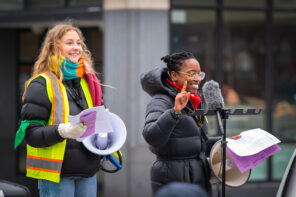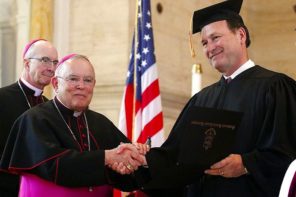A scene from a recent episode of NBC’s Heroes unfolds like a PG-13 version of the X-rated Egyptian myth of Set and Horus.
As that story goes, Horus—the Egyptian sky god—contends with Set, god of chaos and the desert, for control of all of Egypt. The rivalry between the two gods, who are sometimes depicted as brothers, entails seduction, revenge, betrayal and a blush-inducing debate over who left his semen in whom to be settled by the other gods, including Isis, their mother.
More recently in the “Angels and Monsters” episode, Peter Petrelli, one of the flawed heroes at the center of Heroes, has returned from a journey into the future, where he used his empathic ability to acquire the power of Sylar, his nemesis. But Sylar’s knack for understanding how things tick comes with a price—his hunger for knowledge compels him to steal the powers of other superheroes by slicing off the tops of their heads.
 Back in the present, Peter realizes he has seriously underestimated the intensity of the yearning that comes with Sylar’s ability. So when he learns that he and Sylar are both sons of the mysterious Angela Petrelli, rage and desire quickly get the better of his moralistic posturing.
Back in the present, Peter realizes he has seriously underestimated the intensity of the yearning that comes with Sylar’s ability. So when he learns that he and Sylar are both sons of the mysterious Angela Petrelli, rage and desire quickly get the better of his moralistic posturing.
“What other secrets are you hiding from me, mother?” Peter growls as, strapping and shirtless, he goes to work on his horrified mother’s cranium.
Sylar, whose neck Peter has snapped during a telekinetic brawl a moment earlier, pulls himself back together—another ill-gotten skill—just in time to save Angela’s life.
The Essential Queerness of the Hero Archetype
A sexier version of this kind of sweaty, bare-chested man-on-man action is a central feature of some of the myths that form the foundation of Western society. Nearly 5,000 years ago, an account of the tempestuous relationship between civilized Gilgamesh and a wild man named Enkidu marked the shift from oral to written culture in Mesopotamia. Achilles’ wrath at the murder of his lover Patroclus motors the plot of The Iliad, the earliest example of epic poetry in the Greek language. And the conquests of Alexander the Great and his companion Hephaestion—Alexander was defeated only once, noted a cynic philosopher, and that was by Hephaestion’s thighs—laid the groundwork for the subsequent flourishing of the Greek-loving Romans.
The main difference between the enactment of the heroic archetype in the past and the present is our contemporary squeamishness about the homoerotic vibe that usually hums just beneath the surface of the drama. We try to banish that gayness, or at least keep it at bay, but the pesky thing about archetypes is that they’re not very easily controlled.
Consider, for example, the stubborn persistence of the gay meta-narrative in Heroes.
In the middle of the series’ first season, Thomas Dekker, the young actor who portrayed Zack, best friend to indestructible cheerleader Claire Bennett, came up for the part of John Connor in Fox’s Sarah Connor Chronicles, the auspiciously-initialed, post-apocalyptic savior at the heart of the program.
The trouble—from the perspective of Dekker’s agent—was that the producers at Fox might not want the actor playing JC to bring with him the kind of rep that would follow a star associated with a gay character, which is just how Heroes creator/writer Tim Kring envisioned Zack.
So before Dekker left Heroes to take on the role of a teenage messiah, Zack’s timid venture out of the closet was deleted from Kring’s script.
Thus ended the thin thread of a conventional gay narrative in the series. But beneath the hetero-normative plotlines of Heroes, the essential queerness of the hero archetype keeps popping up, trickster-like, to tweak our modern-day discomfort with difference. “You’re different too?” Claire asks Matt Parkman when she realizes that the former LAPD officer is reading her thoughts.
Every Day is a Struggle
In “Company Man,” an episode that aired during the first season of Heroes, Parkman and Ted Sprague, a human nuclear reactor who’s unstable in more ways than one, have invaded the Bennet home to get information from Claire’s father, Noah, a secret operative for a company intent on discovering and capturing people with “special abilities.”
The arc of the series, now in its third season, has tracked the stories of more than a dozen main characters who realize that they’re not like everybody else. Noah Bennet’s company and Pinehearst, another secretive corporation, alternately woo and coerce the specially endowed men and women their investigations uncover. Conflicting auguries of an imminent apocalypse suggest that the sudden crop of aberrant humans could either cause or avert calamity. And Mohinder Suresh, a scientist bent on isolating the genes responsible for superhero abilities, accidentally turns himself into a monster when he tests a serum that’s supposed to help these folks become normal.
“Something inside of me is broken,” Claire says when she and Elle Bishop, who’s also having trouble with being different, decide to lay their fate in the hands of Pinehearst’s team of gene-splicing technicians at the end of another recent episode, “Eris Quod Sum” (“You Will Be What I Am”).
Earlier developments in the series don’t suggest that Claire’s hopes for normalcy will be realized—or that the rest of us would be better off if they were. By the end of “Company Man,” Ted Sprague has nuked the comfortably exurban Bennet house, and Claire’s regenerative ability is the only thing that keeps the rest of the neighborhood from going up in flames.
In “I Am Become Death,” when Peter hops to the future to acquire Sylar’s extraordinary intuition, he finds Sylar acting out his own fantasy of assimilation, complete with a young son, a McMansion and a pair of heavy horn-rims to soften his ravening gaze. “Every day is a struggle,” Sylar confides to Peter a few moments before the tableau of ersatz establishmentarianism vanishes beneath a roiling mushroom cloud.
Surely the sensitive viewer could be forgiven for seeing something queer afoot in all of this.
The Hero Leaves Home and Bed
Denial breeds psychosis, autocracy sparks revolution. The reciprocal relationship between repression and violence—in the psyches of individuals and in the collective experience of human cultures—is as old as myth itself. From the Hebrew Bible to the mass-mediated therapy sessions known as daytime talk shows, the illusion of control begets chaos, and the fear of uncertainty provides fertile ground in which the seeds of the illusion can take root once more.
An element of a larger process that Jonas Salk called “metabiological evolution,” the myth of the hero persists in our cultural DNA as a remedy to this collective affliction. The pattern of departure, initiation and return that defines the hero’s story functions as both a safety valve and a mechanism of social transformation, harnessing the shadowy energies in the depths of the mind to effect change when we need it most.
It’s no accident, then, that Jesus withdrew to the desert, Moses ventured to his mountaintop and the Buddha took his seat under the bodhi tree at times of profound social crisis.
Now note, in these examples and in countless others close at hand, that heeding the hero’s call to departure entails severing or forgoing the bonds of traditional domestic life—a prospect that’s easier to contemplate if the longing for the social and sexual relationships of a householder is attenuated or absent in the heart of the hero.
In monasteries and convents and among the ranks of shamans, sages and spiritual warriors, gay men and women are disproportionately represented not only because those social locations have traditionally existed outside of hetero-normative institutions but also because undertaking the hero’s quest is their metabiological function. To put the matter differently: The birthing of new forms of culture at key junctures in human history is an expression of what might be called “queer generativity.”
All of this explains why pre-modern tales of the hero are so often, well, throbbing with queer sexual energy. And also why the trope of difference inevitably sneaks into modern cultural productions like Heroes, in which the non-hetero-normative dimensions of the archetype are obscured so as not to trouble the narrative of conformity—the bedtime story that every unstable society tells itself in every troubled age.
Early in the current season, Matt Parkman finds himself in a remote sub-Saharan locale, where he seeks the advice of an African shaman endowed with precognitive abilities.
“You must find your totem,” Matt’s host tells him as they stand in the boulder-strewn desert gallery where the shaman paints his visions of the future. “A spirit guide that attaches to your subconscious. It will lead you on your journey.”
“What is that,” asks the jaded telepathic cop. “Some African mystical mojo thing?”
After a beat, the shaman replies, “Carl Jung—analytical psychology.”
The creative team behind Heroes might take as its totem the archetype of the hero—but not the half-baked assimilationist version of the myth that plays out in the drama as Sylar, Claire and other specially endowed human struggle to rid themselves of their difference.
Rather, the unsatisfying muddle of the current storyline calls for a Promethean figure, someone unafraid to heed the call of departure from conventional life as well as from the audience’s expectations. What Heroes needs is another Zack, unbound—a heroically transgressive character who will steal fire from the gods and illuminate the path that will lead us out of our present dark age.




